Top Rankings
Bristol School District ranks among the top 20% of public school district in Connecticut for:
Category
Attribute
Diversity
Most diverse schools (Top 1%)
Community Size
Largest student body (number of students) (Top 1%)
For the 2025 school year, there is 1 public preschool serving 246 students in Bristol School District.
Public Preschools in Bristol School District have a diversity score of 0.65, which is less than the Connecticut public preschool average of 0.70.
Minority enrollment is 52% of the student body (majority Hispanic), which is less than the Connecticut public preschool average of 59% (majority Hispanic).
Overview
This School District
This State (CT)
# Schools
13 Schools
345 Schools
# Students
7,305 Students
132,954 Students
# Teachers
541 Teachers
10,546 Teachers
Student : Teacher Ratio
14:1
14:1
District Rank
Bristol School District, which is ranked within the bottom 50% of all 197 school districts in Connecticut (based off of combined math and reading proficiency testing data) for the 2021-2022 school year.
The school district's graduation rate of 84% has decreased from 87% over five school years.
Overall District Rank
#130 out of 200 school districts
(Bottom 50%)
(Bottom 50%)
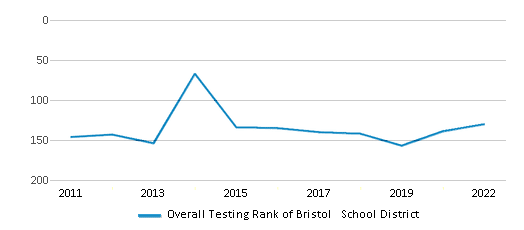
Math Test Scores (% Proficient)
36%
40%
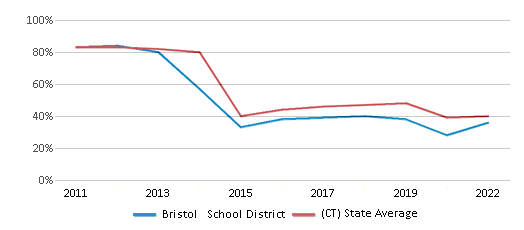
Reading/Language Arts Test Scores (% Proficient)
49%
50%
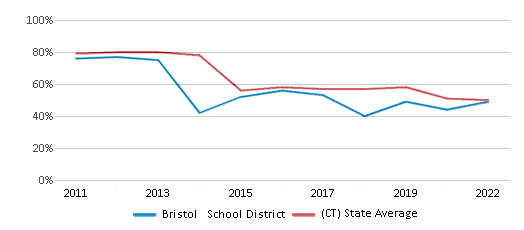
Science Test Scores (% Proficient)
45%
47%
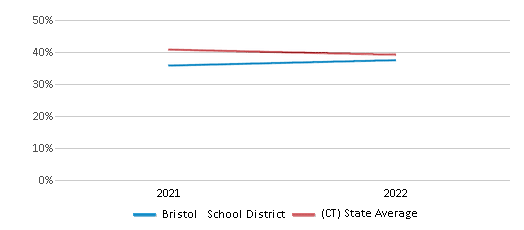
Graduation Rate
84%
89%
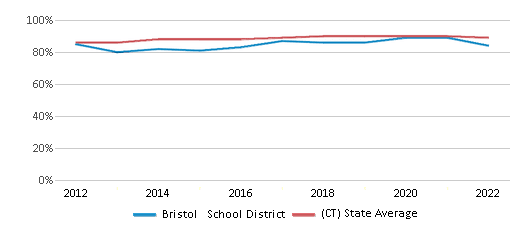
Students by Ethnicity:
Diversity Score
0.66
0.70
# American Indian Students
8 Students
381 Students
% American Indian Students
n/a
n/a
# Asian Students
257 Students
6,332 Students
% Asian Students
4%
5%
# Hispanic Students
2,744 Students
44,965 Students
% Hispanic Students
38%
34%
# Black Students
604 Students
19,832 Students
% Black Students
8%
15%
# White Students
3,251 Students
54,707 Students
% White Students
44%
41%
# Hawaiian Students
3 Students
132 Students
% Hawaiian Students
n/a
n/a
# Two or more races Students
430 Students
6,568 Students
% of Two or more races Students
6%
5%
Students by Grade:
# Students in PK Grade:
246
14,518
# Students in K Grade:
485
19,819
# Students in 1st Grade:
508
19,906
# Students in 2nd Grade:
563
20,278
# Students in 3rd Grade:
506
15,997
# Students in 4th Grade:
578
16,056
# Students in 5th Grade:
507
13,209
# Students in 6th Grade:
566
5,100
# Students in 7th Grade:
555
3,978
# Students in 8th Grade:
578
3,865
# Students in 9th Grade:
596
67
# Students in 10th Grade:
543
64
# Students in 11th Grade:
575
43
# Students in 12th Grade:
499
54
# Ungraded Students:
-
-
District Revenue and Spending
The revenue/student of $28,621 is higher than the state median of $26,157. The school district revenue/student has stayed relatively flat over four school years.
The school district's spending/student of $28,218 is higher than the state median of $25,225. The school district spending/student has stayed relatively flat over four school years.
Total Revenue
$209 MM
$12,920 MM
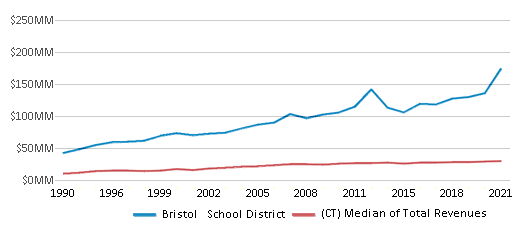
Spending
$206 MM
$12,459 MM
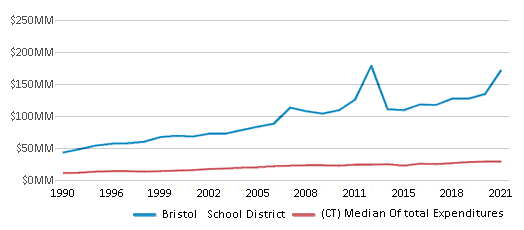
Revenue / Student
$28,621
$26,157
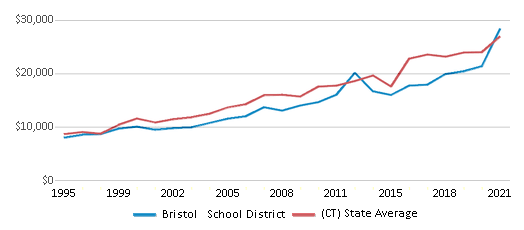
Spending / Student
$28,218
$25,225
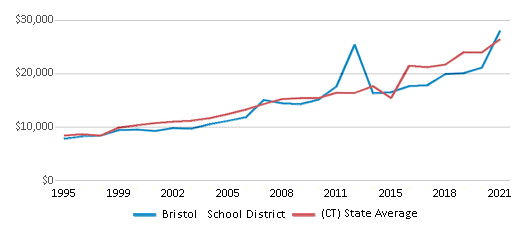
Best Bristol School District Public Preschools (2025)
School
(Math and Reading Proficiency)
(Math and Reading Proficiency)
Location
Grades
Students
Rank: n/an/a
345 Mix St.
Bristol, CT 06010
(860) 584-7072
Bristol, CT 06010
(860) 584-7072
Grades: PK
| 246 students
Recent Articles

What Is A Charter School?
Explore the world of charter schools in this comprehensive guide. Learn about their history, how they operate, and the pros and cons of this educational innovation. Discover key facts about charter schools, including admission policies, demographics, and funding, as well as what to look for when considering a charter school for your child.

10 Reasons Why High School Sports Benefit Students
Discover the 10 compelling reasons why high school sports are beneficial for students. This comprehensive article explores how athletics enhance academic performance, foster personal growth, and develop crucial life skills. From improved fitness and time management to leadership development and community representation, learn why participating in high school sports can be a game-changer for students' overall success and well-being.

February 05, 2025
Understanding the U.S. Department of Education: Structure, Impact, and EvolutionWe explore how the Department of Education shapes American education, from its cabinet-level leadership to its impact on millions of students, written for general audiences seeking clarity on this vital institution.





